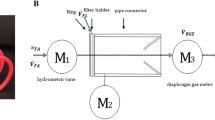Abstract
A system is described for the collection of volatiles produced by plants and insects that minimizes stresses on the plant or insect in an environment that is free from chemical impurities. Air entering a volatile collection chamber containing insects and/or plants was purified using a nonwoven fabric medium infused with charcoal. When three layers of this material were used, the total amount of impurities detected by gas chromatography was less than 40 ng/hr at a collection rate of 1 L/min. The air filtration system can maintain this level of air purification for 96 hr at an air flow of 0.43 m/sec, or a total volume of approximately 750,000 L of air. The air filtration system did not alter the relative humidity of the purified air compared to the relative humidity of ambient air. A multiport collector system was developed for use with the insect volatile collection system and enabled up to three samples to be collected without disturbing the system.
Similar content being viewed by others
References
Baker, T.C., Gaston, L.K., Pope, M.M., Kuenen, L.P.S., andVetter, R. 1981. A high efficiency collection device for quantifying sex pheromones volatilized from female glands and synthetic sources.J. Chem. Ecol. 7:961–968.
Golub, M., andWeatherston, J. 1984. Techniques for extracting and collecting sex pheromones from live insects and artificial sources, pp. 287–322,in H.E. Hummel and T.A. Miller (eds.). Techniques in Pheromone Research. Springer-Verlag, New York.
Golub, M., Weatherston, J., andBenn, M.H. 1983. The measurement of release rates of gossyplure from controlled release formulations by the mini-airflow method.J. Chem. Ecol. 9:323–333.
Grob, J. J. 1982. Band broadening in space and the retention gap in capillary gas chromatography.J. Chromatogr. 237:15–23.
Heath, R.R., McLaughun, J.R., Proshold, F., andTeal, P.E.A. 1991. Periodicity of female sex pheromone titer and release in Heliothis subflexa and H. virescens (Lepidoptera: Noctuidae).Ann. Entomol. Soc. Am. 84(2): 182–189.
Klun, J.A., Bierl-Leonhardt, B.A., Plimmer, J.R., Sparks, A.N., Primiana, M., Chapman, O.L., Lepone, G., andLee, G.H. 1980. Sex pheromone chemistry of the female tobacco budworm moth,Heliothis virescens.J. Chem. Ecol. 6:177–183.
Nation, J.L. 1990. Biology of pheromone release by male Caribbean fruit flies,Anastrepha suspensa (Diptera: Tephritidae).J. Chem. Ecol. 16:553–572.
Murphy, R.E. 1989. The Fractionation Gap: An Optimized Coupling of Fused Silica Columns in Open Tubular Gas Chromatography, Master's thesis. University of Florida, Gainesville.
Shani, A., andLacey, M.J. 1984. Convenient method applicable to single insects for collection and measurements of blend ratios of airborne pheromones from artificial sources.J. Chem. Ecol. 10:1677–1692.
Sower, L.L., Coffelt, J.A., andVick, K.W. 1973. Sex pheromone: A single method of obtaining relatively pure material from females of five species of moths.J. Econ. Entomol. 66:1220–1222.
Teal, P.E.A., Heath, R.R., Tumlinson, J.E., andMcLaughlin, J.R. 1981. Identification of a sex pheromone ofHeliothis subflexa (GN) (Lepidoptera: Noctuidae) and field trapping studies using different blends of components.J. Chem. Ecol. 7:1011–1022.
Teal, P.E.A., Tumlinson, J.H., andHeath, R.R. 1986. Chemical and behavioral analysis of volatile sex pheromone components released by callingHeliothis virescens (F.) females (Lepidoptera: Noctuidae).J. Chem. Ecol. 12:107–126.
Tollsten, L., andBergstrom, G. 1988. Headspace volatiles of whole plants and macerated plant parts ofBrassica andSinapis.Phytochemistry 27:4013–4018.
Tumlinson, J.H., Heath, R.R., andTeal, P.E.A. 1982. Analysis of chemical communications systems of Lepidoptera, pp. 1–25,in B.A. Leonhardt and M. Beroza (eds.). Insect Pheromone Technology: Chemistry and Applications, American Chemical Society, Washington, D.C.
Author information
Authors and Affiliations
Rights and permissions
About this article
Cite this article
Heath, R.R., Manukian, A. Development and evaluation of systems to collect volatile semiochemicals from insects and plants using a charcoal-infused medium for air purification. J Chem Ecol 18, 1209–1226 (1992). https://doi.org/10.1007/BF00980075
Received:
Accepted:
Issue Date:
DOI: https://doi.org/10.1007/BF00980075




